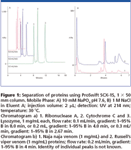A New High-Resolution Strong Cation-Exchange 1 mm i.d. Column for the Separation of Proteins
LCGC Asia Pacific
Dionex Application Note
Srinivasa Rao, Kelly Flook, Yury Agroskin, and Chris Pohl, Dionex Corporation
The new 1 mm i.d. ProSwift® strong cation-exchange (SCX) column is a polymethacrylate-based monolithic column with sulfonate functionality (1). The column is available in 1 × 50 mm format and is used for high-resolution separation of proteins.
Experimental
Dionex ICS-3000 LC system with DP pump, VWD absorbance detector, AS auto-sampler, and TCC-100 thermostatted column compartment was used.
Chromatography was controlled by the Chromeleon® Chromatography Data System.
Materials
Standard proteins, Naja naja and Russell's viper snake venoms, and other analytical-grade chemicals were obtained from Sigma.
Results and Discussion
Earlier, reversed-phase, weak and strong anion-exchange, and weak cation-exchange monolithic columns were introduced in a 1 mm i.d. format for protein separations. The new ProSwift SCX-1S column has a pore structure designed for efficient separation of proteins at elevated linear velocities. Due to its low operating backpressure, flow rates of up to 0.3 mL/min (>6 mm/s) can be employed while maintaining high resolution. In addition, chromatography using ProSwift SCX-1S columns can be performed on standard HPLC systems with only minor plumbing changes to minimize instrument delay volumes. Operation at reduced flow rates minimizes consumption of sample and eluents, greatly reducing the cost of analysis.
Separation of a standard protein mixture at increasing flow rates and constant column volume gradient is shown in Figure 1a. When the flow rate was increased from 0.1 mL/min to 0.3 mL/min, the resolution reduced modestly from 8.82 to 6.58. This allows separations to be completed in significantly shorter times, which helps increase productivity. Figure 1b shows the separation of two different snake venom proteins in < 10 min.

Figure 1
Conclusion
The ProSwift SCX-1S, 1 mm i.d. column provides high-resolution and cost-effective separation of simple and complex protein mixtures. The high loading capacity of the column makes it useful for both one-dimensional and two-dimensional chromatography platforms.
PEEK is a trademark of Victrex PLC.
Chromeleon and ProSwift are registered trademarks of Dionex Corporation.
References
(1) ProSwift IEX manual and ProSwift IEX data sheet are available at www.dionex.com.

Dionex Corporation
1228 Titan Way, P.O. Box 3603, Sunnyvale, CA 94088
tel. (408)737-0700; fax (408)730-9403
Website: www.dionex.com















